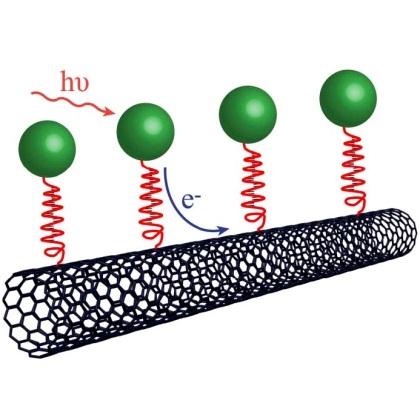Researchers have succeeded in developing a new type of solar cell capable of repairing itself, similar to natural photosynthetic systems found in plants, through the use of carbon nanotubes and DNA

Researchers have succeeded in developing a new type of solar cell capable of repairing itself, similar to natural photosynthetic systems found in plants, through the use of carbon nanotubes and DNA - an approach that aims to extend the shelf life of the product and reduce its production costs.
"We were able to produce artificial photosystems using optical nanomaterials to harness solar energy and convert it into electrical energy," said Jong Hyun Choi, a professor of mechanical engineering at Purdue University (Purdue, a large public university in the state of Indiana).
The design of the new cell takes advantage of the unique electrical properties of structures called "single-walled carbon nanotubes" and their use as "molecular wires for cells that absorb light", explained the lead researcher. He added that although the research is only in its basic stage, the new approach provides many possibilities for the industry.
Photo-electro-chemical cells convert sunlight into electricity and use an electrolyte - a liquid that conducts electricity - in order to transfer electrons from one point to another and generate electricity in the process. The cells contain coloring substances - chlorophyll-like molecules - which are able to absorb sunlight (chromophores) and which break down over time as a result of their exposure to sunlight. "The significant disadvantage of ordinary photo-electrochemical cells lies in this breakdown," the researcher points out. The innovative technology overcomes this problem in exactly the same way that nature did it - by constantly replacing the damaged dyes with new ones. "This form of self-renewal occurs in plants every hour," explains the researcher.
The original idea could enable the development of an innovative type of photo-electro-chemical cell capable of continuing its activity in full utilization indefinitely, as long as new chromophores are added to the cell.
The research findings were published in a presentation given during the International Mechanical Engineering Conference held in Canada and the idea was also revealed in an article published online on the website of the International Society for Optics and Photonics)Link to the article(.
The carbon nanotubes function as a substrate on which the DNA helices are anchored. The DNA molecule is engineered so that it contains a defined sequence of building blocks called nucleotides, a sequence that allows it to recognize and bind to defined chromophores. "The DNA molecule recognizes the color molecules and then the system organizes itself," explains the researcher.
When the time comes to replace the damaged chromophores, this can be done through chemical processes or by adding new DNA coils with a different nucleotide sequence that can push out the damaged color molecules. In the next step, it will be possible to add new chromophores.
Two factors are essential in order for the new technology to be able to successfully imitate the self-repair mechanism in nature: molecular recognition and thermodynamic metastability (delicate equilibrium) - that is, the system's ability to constantly dissolve and reorganize.
The new study is a continuation of a previous study by researcher Choi that was done in collaboration with MIT University and the University of Illinois. In the previous study, the scientists used biological chromophores taken from bacteria and the research findings were published in the scientific journal Nature Chemistry (The findings of the previous study). However, the use of natural chromophores is problematic, and it is necessary to extract and isolate them from bacteria - a process that would be too expensive for the industry, adds the lead researcher. "Thus, instead of using biological chromophores, we resorted to using artificial chromophores consisting of dyes called porphyrins (The description on Wikipedia)," notes the researcher.
